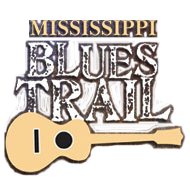Abbay & Leatherman
Abbay & Leatherman - Robinsonville
Abbay & Leatherman, one of the oldest and largest cotton plantations in the Delta, is known to music enthusiasts worldwide as the boyhood home of blues icon Robert Johnson (c. 1912-1938). Johnson lived here with his family in a tenant shack by the levee during the 1920s. The powerful and impassioned recordings he made in 1936-37 are often cited as the foundation of rock ‘n’ roll, and the facts, fantasies, and mysteries of his life and death are a continuing source of intrigue.
Robert Johnson would become known as the “King of the Delta Blues,” heralded not only as a dramatic and emotional vocalist but also as an innovative and influential master of the guitar and a blues poet who could chill listeners with the dark depths of his lyrical vision. But he was recalled only as a good harmonica player who had limited skills as a guitarist during his adolescent years here on the Abbay & Leatherman plantation. Johnson left the Delta around 1930, but when he reappeared about two years later he possessed such formidable guitar technique that Robinsonville blues luminary Son House later remarked that Johnson must have “sold his soul to the devil.” The 1986 Hollywood movie Crossroads was based on the legend of Johnson’s alleged deal with the devil, as were several subsequent documentaries and books.
Johnson was born in Hazlehurst, Mississippi, the illegitimate son of Julia Dodds and Noah Johnson. May 8, 1911, is often cited as his birthdate, although some sources, including a census listing and his death certificate, point to 1912. His mother once sent him to Memphis to live with his father, Charles Dodds (aka Charles Spencer) but took him back after she married Willie “Dusty” Willis at Abbay & Leatherman in 1916. Johnson, then known as Robert Spencer, reportedly lived here for a decade or more beginning in about 1918. Records from the nearby Indian Creek School verify his enrollment there. However, the 1920 census shows Will and Julia Willis and Robert Spencer in Lucas, Arkansas, in the same county where Abbay & Leatherman owner Samuel Richard Leatherman once acquired additional cotton-farming property.
Johnson married Virginia Travis in Tunica County in 1929, but his 16-year-old wife died in childbirth on April 10, 1930. Back in Hazlehurst, Johnson found himself a new wife, Callie Craft, as well as a musical mentor, guitarist Ike Zinnerman. He soon left married life behind to pursue a career as an itinerant musician, now able to play alongside the best bluesmen in the Delta, including Son House and Willie Brown, and to entertain crowds wherever he went with a reputation for being able to play any song after hearing it just once. He began recording in 1936, and though his recordings proved highly influential in the course of blues and rock ‘n’ roll history, few of them sold well during his lifetime. His death near Greenwood on August 16, 1938, has often been attributed to poisoning, although the case remains a mystery. Johnson was inducted into the Blues Hall of Fame in its first year, 1980, and into the Rock and Roll Hall of Fame also in its initial year, 1986.
Captions
At its peak, more than 450 families lived and worked on Abbey & Leatherman, according to Bobby Leatherman. The plantation traces its history back to 1832 when Richard Abbay purchased land from the Chickasaw Indian tribe.
“I Believe I’ll Dust My Broom” was one of many of Robert Johnson’s classics later covered by blues and rock performers. Others include “Sweet Home Chicago,” “Cross Road Blues,” “Love In Vain,” “Come On In My Kitchen,” and “Stop Breakin’ Down Blues.” The mystique surrounding Robert Johnson helped propel the boxed set, The Complete Recordings, to the Billboard pop music charts in 1990. It was the first album to feature a photograph of Johnson; earlier album covers, including that of the historic 1961 compilation King of the Delta Blues Singers, relied on illustrators’ imaginations.
The deep Delta blues of Son House and fellow Delta legends Charley Patton and Willie Brown was a major inspiration to Robert Johnson. House, Brown, Louise Johnson, Howlin’ Wolf, Fiddlin’ Joe Martin, Woodrow Adams, Willie Johnson, and Tommy Bankhead were among the blues recording artists who lived and performed at various times on plantations in this area.
Willie Coffee and R. L. Windum were local childhood friends of Robert Johnson. Coffee was one of a number of musicians who played in the area at house parties and juke joints but who never recorded commercially; others he recalled included Willie Polk, Robert Newman, Henry Neyland, Mitchell Winters, Mamie Fletch, Will Lovinheart, Walter Rogers, and Sol Henderson. Windum (1910-2003) and Johnson played harmonica together as youngsters. He recalled “Three O’Clock in the Morning” as a favorite harmonica piece of Johnson’s.
content © Mississippi Blues Commission
[ BACK TO TOP ]

